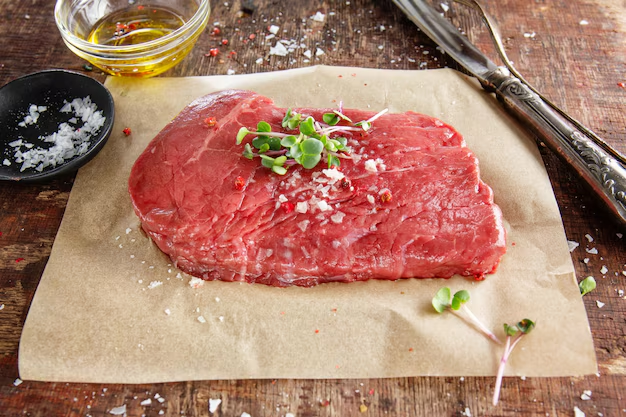How Long Can You Keep Beef in the Fridge? Find Out Here!
Stowing away groceries can feel like a game of Jenga, trying to fit all the pieces perfectly while ensuring nothing topples over or goes bad. Among those jumbled pieces is beef—a staple protein in many households. But how long can beef safely stay in the refrigerator without spoiling? Knowing this could save your meal plans and, more importantly, help keep you healthy. Let’s dive into the nuances of beef storage and answer this common yet crucial question.
🥩 Understanding Beef Shelf Life: More Than Meets the Eye
Factors Affecting Beef Longevity
When talking about beef's refrigerator lifespan, we aren't setting one-size-fits-all rules. Several factors interplay to determine how long beef remains safe and tasty. Here's what you need to consider:
Cut and Type: Ground beef and whole cuts like steaks or roasts have different shelf lives. Ground beef tends to spoil faster due to its larger surface area.
Packaging: The type of wrapping can extend or curtail freshness. Vacuum-sealed beef often lasts longer than beef in supermarket packaging.
Temperature Consistency: Keep your fridge around 34-40°F (1-4°C) to maximize freshness. Temperature fluctuations accelerate spoilage.
Initial Quality: Fresher beef stays good longer. Always check use-by dates and opt for beef that's bright red (unless it’s been vacuum-packed, where a darker color is normal).
General Guidelines for Refrigerating Beef
Now that we understand the variables, let's look at some general guidelines for beef storage:
Ground Beef: Best used within 1-2 days. Quick cooking methods like frying or sautéing work well with ground beef nearing its expiration.
Beef Steaks and Roasts: Generally safe for 3-5 days. A perfect timeline for marinating steaks for a few days before grilling.
Cooked Beef: Can last 3-4 days. Perfect for meal prep, ensuring hearty lunches and dinners are ready to go.
🕒 Storing Beef for Quality and Safety: Best Practices
How to Store Beef in the Refrigerator
Beef should be stored in the coldest part of the refrigerator, and if not packaged securely by the store, should be rewrapped tightly:
Tips for Optimal Refrigeration:
Use the Right Containers: Airtight containers or heavy-duty aluminum foil or plastic wrap help lock in freshness and prevent odors from penetrating.
Label Everything: Note down the purchase and expected use-by date. A simple habit that leads to significant waste reduction!
Organize Fridge Space: Store beef lower in the fridge to prevent cross-contamination from drips to other foods.
Spotting Spoiled Beef
A trained nose and a sharp eye are your best tools here. Signs of spoilage include:
Unpleasant Odor: Fresh beef has a subtle smell. Any sour or ammonia-like odors are red flags.
Discoloration: While some browning is normal, it shouldn't dominate the beef. Bright red is the standard, though vacuum-packed beef may appear purplish.
Slimy Texture: If the beef feels tacky or slimy, it's time to toss it.
🌡️ Extending Shelf Life: Freezing Beef
Maximizing Beef Longevity by Freezing
When planning long-term storage, freezing beef is the best option. Here's how to do it effectively:
Wrap It Right: For ultimate protection, use freezer paper, heavy-duty foil, or vacuum seal when storing beef.
Avoid Freezer Burn: Ensure no part of the beef is exposed to air. Freezer burn might not be dangerous, but it impacts texture and taste.
Proper Labeling: Just as in refrigeration, note the freezing date. Generally, beef maintains quality for 4-12 months in the freezer.
Thawing Frozen Beef Safely
Frozen beef should be thawed properly to ensure safety:
Refrigerator Thawing: Best and safest method, allowing for slow and even thawing. This can take 24 hours or more.
Cold Water Bath: If short on time, submerge beef in cold water, changing it every 30 minutes. Do not leave it out at room temperature.
Avoid Microwave Thawing: It can cause uneven thawing and potential bacteria growth in the warmer parts.
📋 Handy Tips for Beef Storage
To enhance your beef storage practice, take a moment to memorize these handy tips:
💡 Beef Storage Tips:
- Keep your fridge at or below 40°F (4°C).
- Use beef within 1-2 days for ground beef and 3-5 days for steaks and roasts.
- Freeze any beef you won't use within these time frames.
- Avoid thawing beef on the countertop to prevent bacterial growth.
🥡 Incorporating Safe Beef Practices into Your Kitchen Routine
Meal Planning with Beef Shelf Life in Mind
Understanding beef's shelf life helps significantly with meal prep and planning. By shopping with weekly menus in mind, you can make informed choices on which cuts to buy and use promptly:
Weekly Meal Plan: Align meal plans with shelf life—use ground beef early in the week for tacos or burgers, saving roasts for weekend dinners.
Batch Cooking: Opt for cooking in large batches early in the week and refrigerating or freezing cooked portions.
This approach not only ensures maximum freshness but also saves time and minimizes food waste.
Embracing a Conscious Kitchen
Adapting to these practices leads to more than just preserving beef:
Food Safety First: Reducing the risk of foodborne illnesses by understanding and implementing proper storage techniques.
Sustainable Practices: Conscious planning, storage, and usage can translate into impactful steps toward reducing household food waste.
Your kitchen is more than a place to cook; it's a space where informed habits lead to healthier living and resource conservation.
Wrapping Up: The Art of Smart Beef Storage
Navigating the lakes and rivers of beef storage doesn't need to be daunting. By using these guidelines, you ensure not just safety, but the best possible flavors ready to be unleashed in your dishes. Cook, savor, and enjoy knowing your culinary creations are crafted from well-kept ingredients.
With beef, as rightfully with all food, the goal is simple yet profound: consume wisely, store efficiently, and enjoy greatly. Here's to a delicious, efficient, and waste-conscious kitchen! 🥳
